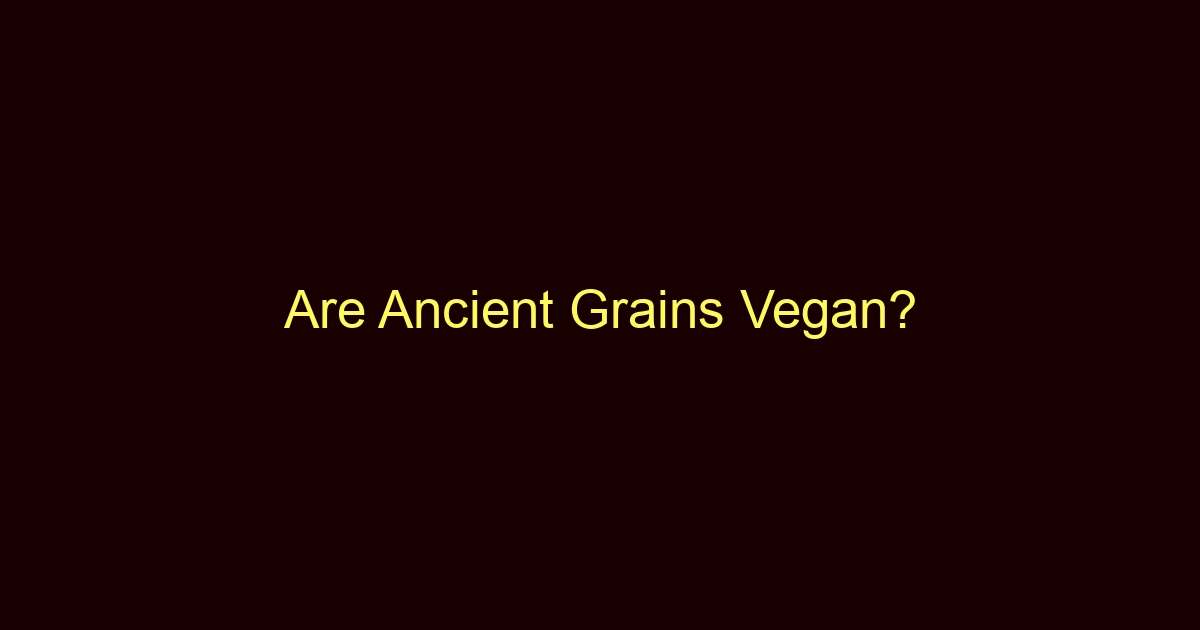In recent years, there’s been a burgeoning interest in what are known as ‘ancient grains’. But are these age-old staples compatible with a modern vegan lifestyle? This article will explore what ancient grains are, what they’re made from, their uses, and importantly, whether they align with a vegan diet.
What are Ancient Grains?
Ancient grains refer to grain varieties that have remained largely unchanged for hundreds or even thousands of years. Unlike modern wheat, which has been extensively cross-bred and hybridized, ancient grains have been spared from significant modification, thereby retaining their original nutritional content and unique flavors.
These grains encompass a broad range of cereals including, but not limited to, quinoa, amaranth, spelt, teff, freekeh, farro, kamut, and millet. Many of these grains have been staples in various cultures around the globe, owing to their adaptability to diverse growing conditions and their robust nutritional profiles.
Ancient grains are lauded for their health benefits. They’re often rich in protein, fiber, and essential nutrients such as B vitamins, magnesium, and iron. Plus, they have an appealing, hearty texture and a nutty, earthy flavor that can add depth to many dishes.
What are Ancient Grains Made Of?
This might seem like a strange question, but it’s straightforward – ancient grains are made from, well, grains! The term “grain” refers to the seed or fruit of a cereal grass plant. Each grain consists of three parts: the bran (outer layer), the germ (the embryo of the seed), and the endosperm (the energy-storage region of the seed). All ancient grains contain these three parts.
Each ancient grain has its unique characteristics, with variations in size, color, flavor, and nutritional composition. However, they all have one thing in common: they’re plant-derived and do not contain any animal-based ingredients.
What are Ancient Grains Used For?
Ancient grains are incredibly versatile and can be used in a multitude of dishes. They can serve as the main component in salads, stews, and stir-fries, as a side dish, or as a wholesome addition to baked goods. They can also be ground into flour and used in baking or as a thickening agent in soups and sauces.
What Foods Contain Ancient Grains?
You’ll find ancient grains in a wide variety of foods. They’re often used in bread, cereals, pasta, and other baked goods. They can also be found in grain-based salads, side dishes, or as a base for grain bowls. Many snack products like granola bars, crackers, and chips now feature ancient grains as well.
Are Ancient Grains Vegan?
Yes, ancient grains are vegan. They’re derived entirely from plants, with no animal products or by-products involved in their cultivation or processing. This makes them a perfect fit within a vegan diet.
Moreover, many ancient grains are complete proteins (such as quinoa and amaranth), meaning they contain all the essential amino acids your body needs. This feature, combined with their high fiber content and rich nutrient density, makes ancient grains an excellent choice for vegans seeking diverse sources of plant-based protein.
Can Vegans Eat Ancient Grains and Why?
Absolutely, vegans can and should incorporate ancient grains into their diet. As these grains are plant-based, they naturally fit into a vegan lifestyle. But the benefits go beyond their vegan status. Ancient grains offer an impressive array of nutrients, including fiber, protein, and a variety of vitamins and minerals.
For vegans, the protein content of these grains is of particular interest. As many ancient grains are complete proteins, they can contribute to ensuring adequate protein intake, which is an important consideration in vegan nutrition.
Are Ancient Grains Safe?
For most people, ancient grains are safe to consume and can contribute to a balanced diet. However, some ancient grains (like spelt and kamut) contain gluten, so those with gluten intolerance or celiac disease should avoid these varieties or opt for gluten-free ancient grains like quinoa, millet, or amaranth.
Final Thoughts
In conclusion, ancient grains are a delightful, nutrient-rich, and vegan-friendly addition to a balanced diet. They provide an assortment of nutrients, are highly versatile in the kitchen, and bring a taste of history to our modern plates. Whether you’re a dedicated vegan or someone who just appreciates good food, ancient grains are worth exploring.

